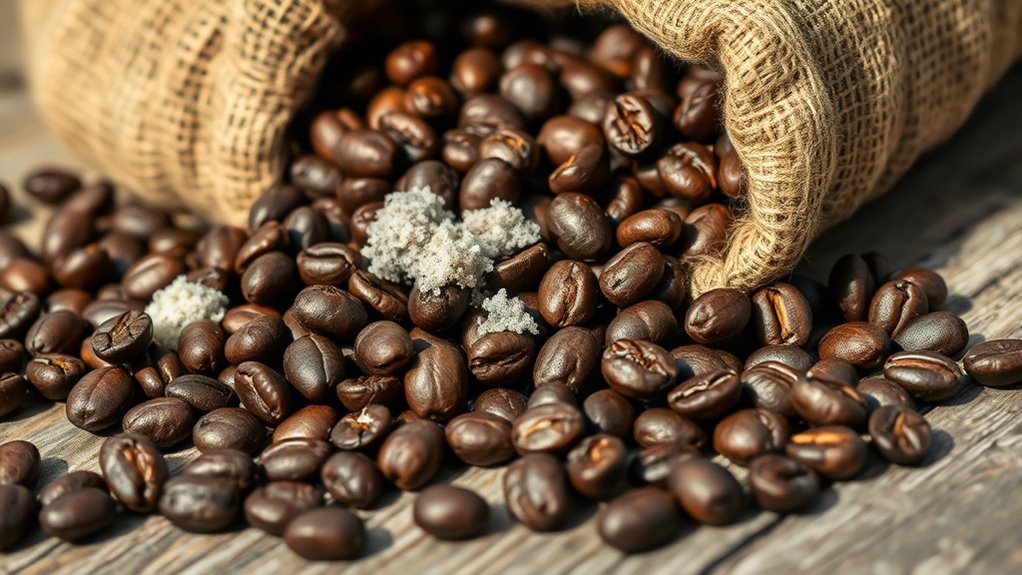Mycotoxins are toxic substances produced by molds that can grow on coffee beans when stored improperly in humid, warm conditions. Consuming contaminated coffee over time may pose health risks like immune suppression and digestive issues. While roasting and processing can reduce some toxins, they might not eliminate all. To minimize exposure, choose reputable brands and store your coffee correctly. If you stay aware of these risks, you’ll be better prepared to protect yourself from potential harm.
Key Takeaways
- Coffee beans can be contaminated with mycotoxins from mold growth during improper storage.
- Proper processing and roasting reduce but may not fully eliminate mycotoxins in coffee.
- Consuming high-quality, tested, or organic coffee lowers the risk of mycotoxin exposure.
- Good storage practices at home, like keeping coffee dry and cool, help prevent mold development.
- While some contamination exists, regulated standards and testing minimize health risks from coffee.

Have you ever wondered what mycotoxins are and how they might affect your health? These toxic compounds are produced by molds that grow on crops, especially grains, during improper storage or humid conditions. Grain contamination with mycotoxins is a vital concern because it can lead to contaminated food products, including coffee beans. When mold spores settle on grains, they produce these harmful substances that can survive processing and enter your diet. Consuming contaminated foods over time may result in various health issues, such as immune suppression, digestive problems, or even more serious conditions like carcinogenic effects. That’s why understanding how to recognize, prevent, and detoxify these toxins is essential.
The journey starts with awareness of grain contamination. Coffee beans, for example, are often stored in warm, moist environments that encourage mold growth. If not properly handled or processed, these beans can harbor mycotoxins, which are invisible and resilient. Luckily, several detoxification methods exist to reduce or eliminate mycotoxins from contaminated products. These include physical methods like sorting and removing moldy beans, which can markedly cut down toxin levels before roasting. Additionally, certain processing techniques, such as washing, steeping, or using activated charcoal, can help bind or remove some mycotoxins. Roasting, while effective against many pathogens, may not fully eradicate all mycotoxins, so relying solely on heat isn’t enough. Some newer methods involve specialized chemical treatments or the use of natural binders like bentonite clay to absorb toxins during processing.
As a consumer, it’s essential to choose reputable brands that prioritize quality control and use advanced detoxification methods. Look for certifications and transparent sourcing practices, as trustworthy companies often test their products for mycotoxin levels and employ effective detox strategies. Proper storage at home also plays a role—keep your coffee in a cool, dry place to prevent mold growth. If you’re concerned about contamination, you might consider investing in lab-tested products or organic options that are less likely to be contaminated with harmful molds. Remember, while the presence of mycotoxins in food can’t always be entirely avoided, minimizing your exposure is within your control through informed choices, proper storage, and demanding high-quality standards from producers.
Frequently Asked Questions
Can Mycotoxins Be Completely Eliminated From Coffee?
You ask if mycotoxins can be completely eliminated from coffee. While detox methods like roasting and advanced filtration reduce their levels, it’s unlikely to remove all mycotoxins entirely. Regulatory standards set safe limits, but some residues may remain. To minimize exposure, choose high-quality coffee from reputable sources that follow strict safety protocols, and consider brewing methods that can further lower potential contaminants.
Do Organic Coffees Contain Fewer Mycotoxins?
Like choosing between a clear stream or a murky pond, your coffee’s purity matters. Organic coffees often contain fewer pesticide residues, making them a better choice. While they may not always have fewer mycotoxins than conventional options, organic farming’s strict standards can reduce contamination risks. So, if you’re aiming for a cleaner brew, opting for organic might be your best move to minimize unwanted toxins.
Are Certain Coffee Brewing Methods More Likely to Release Mycotoxins?
You might wonder if your brewing method affects mycotoxin levels. Higher brewing temperatures can increase the release of mycotoxins, especially if you use a fine coffee grind that exposes more surface area. Brewing methods like French press or espresso, which involve hotter water and shorter contact times, may release more mycotoxins compared to cooler, longer brewing methods. Adjusting temperature and grind size can help minimize your exposure.
How Do Mycotoxin Levels Vary by Coffee Origin?
You might notice that mycotoxin levels vary depending on coffee origin. Climate impact plays a role, as humid, warm environments foster mold growth. Additionally, harvesting practices matter—sustainable, careful picking reduces mold contamination. By choosing coffee from regions with controlled climate conditions and responsible harvesting, you can lower your risk of exposure. Being mindful of origin helps you enjoy your coffee while minimizing potential health concerns related to mycotoxins.
What Are the Health Symptoms of Mycotoxin Exposure From Coffee?
Think of mycotoxin exposure like a sneaky fog settling over your health. You might notice symptoms like headaches, fatigue, or digestive discomfort, which are clues for symptom identification. If you’re toxin sensitive, these signs could hit harder or sooner. Staying alert helps you spot early warning signs, so you can take action. Recognizing how your body reacts is key to managing potential risks from mycotoxins in coffee.
Conclusion
Now that you understand the truth about mycotoxins, it’s clear that careful caffeine consumption can prevent potential health hazards. By being vigilant about your coffee choices, you protect yourself from possible pitfalls and prioritize your well-being. Remember, moderation and mindful sourcing make a massive difference. So, savor your coffee with confidence, knowing you’re taking steps to stay safe, sound, and well-informed. Your health hinges on these mindful, measured moments.









